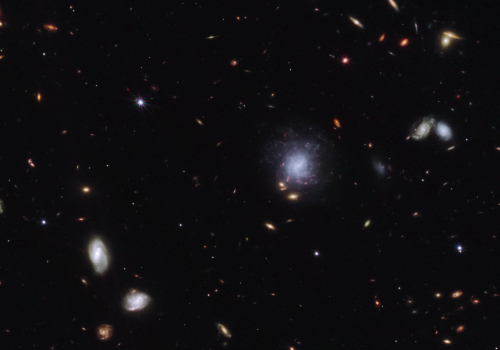 A team of scientists has used multiple space and ground-based telescopes, including NASA’s James Webb Space Telescope (JWST), to observe an exceptionally bright gamma-ray burst (GRB 230307A) and identify the neutron star merger that generated an explosion to create it. They were able to detect the chemical element tellurium in the explosion’s aftermath. Other elements like iodine - needed for much of life on Earth, are also likely to be present among the ejected material. The team's fascinating study has been published in Nature.
A team of scientists has used multiple space and ground-based telescopes, including NASA’s James Webb Space Telescope (JWST), to observe an exceptionally bright gamma-ray burst (GRB 230307A) and identify the neutron star merger that generated an explosion to create it. They were able to detect the chemical element tellurium in the explosion’s aftermath. Other elements like iodine - needed for much of life on Earth, are also likely to be present among the ejected material. The team's fascinating study has been published in Nature.
The gamma-ray burst that the team observed is particularly remarkable. It is the second brightest seen in over 50 years, about 1,000 times brighter than a typical gamma-ray burst that NASA's Fermi Gamma-ray Space Telescope observes. It also lasted for 200 seconds, placing it firmly in the category of long duration gamma-ray bursts.
Assistant Professor and Ad Astra Fellow at UCD School of Physics, Dr Antonio Martin-Carrillo is a co-author on the study. His work helped to prove that the source of this gamma-ray burst was a kilonova. A kilonova is an explosion produced by a neutron star merging with either a black hole or with another neutron star. Understanding the physical processes behind these astronomical events is key to uncovering how many of the elements in the periodic table - such as gold, are created in the Universe and thus, how Earth was formed.
Dr Martin-Carrillo explained, “This was a very challenging and exciting project to be involved in. After an initial JWST observation, we could not clearly explain what the images were showing us. From earlier data, using ground-based telescopes, we thought we were observing a kilonova, which until now had only been seen clearly in one case.
However, some properties of the image obtained with JWST suggested that the source could be a supernova, a much more powerful explosion associated with the death of massive stars. We decided to request a second JWST observation and this gave us conclusive evidence that we had witnessed the merger of two neutron stars, with the results exactly matching the properties of an event seen in 2017 associated with gravitational waves. To further show evidence of the kilonova, we used physical models to explain the temporal evolution of the brightness of this event."
 An intensive series of observations from the ground and from space helped to pinpoint the source of the gamma-ray burst and track how its brightness changed. This is an example of how collaboration of many telescopes on the ground and in space allows scientists to piece together a wealth of information and witness changes in the universe as they unfold.
An intensive series of observations from the ground and from space helped to pinpoint the source of the gamma-ray burst and track how its brightness changed. This is an example of how collaboration of many telescopes on the ground and in space allows scientists to piece together a wealth of information and witness changes in the universe as they unfold.
The highly sensitive infrared capabilities of JWST helped scientists identify the home address of the two neutron stars that created the kilonova: a spiral galaxy about 120,000 light-years away from the site of the merger. Prior to their venture, they were once two normal massive stars that formed a binary system in their home spiral galaxy. Since the duo was gravitationally bound, both stars were launched together on two separate occasions: when one among the pair exploded as a supernova and became a neutron star, and when the other star followed suit.
The neutron stars remained as a binary system despite two explosive jolts and were kicked out of their home galaxy. The pair travelled approximately the equivalent of the Milky Way galaxy’s diameter before merging several hundred million years later. Scientists expect to find even more kilonovas in the future due to the increasing opportunities to have space and ground-based telescopes work in complementary ways to study changes in the universe.
Further Information
Read more about the study on NASA's website